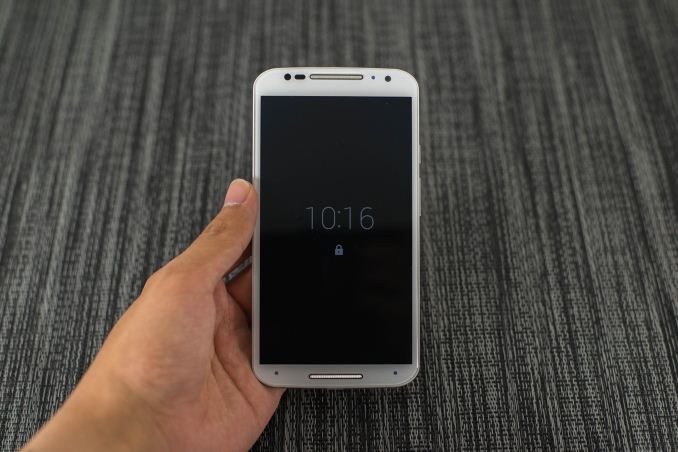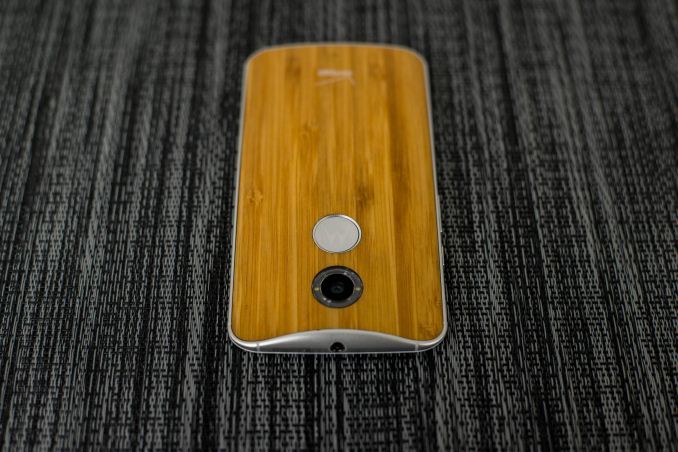The New Motorola Moto X (2nd Gen) Review
by Joshua Ho on September 17, 2014 9:00 AM EST- Posted in
- Smartphones
- Motorola
- Android
- Mobile
Final Words
The first Moto X was, and still is a great phone. Even if the camera isn’t all that great, the display not all that accurate, and the specs not all that impressive, the ergonomics of it are incredible. Motorola had designed one of the most ergonomic smartphones around last year, with plenty of new and innovative features that actually worked. Even if the camera turned out to be a bad bet, it’s hard to fault Motorola for trying new technologies. While I found Touchless Controls to be a bit limited in use, Active Display was and still is a fantastic feature and an excellent demonstration of how AMOLED can enable features at lower power than LCD can.
The new Moto X builds on this foundation. To start, the new industrial and material design are really one of the best in the industry. While it took a while for the look of the phone to grow on me, the improved in-hand feel was immediately obvious to me. I would argue that it’s about as good as the One (M8), as while the in-hand feel of the M8 is better the Moto X has a cleaner design. In addition, ergonomics on the Moto X are noticeably better. Motorola has also invested a great deal of work into their antenna tuner, and while it isn’t something that I can accurately test I’ve never really experienced significant deathgrip issues. Motorola has really paid a lot of attention to this, as they seem to use a Cypress CapSense chip in ways that I’ve never seen before. All of this work seems to be done with the goal of enabling the material and industrial design that few other OEMs can pull off.
The next piece that really tells the story of the new Moto X is software. While the actual ROM itself seems to have some stability issues such as reboots, app crashes, and other oddness, the functionality is fantastic. While I don’t really think that AOSP UI is the best interface for Android, Motorola’s strategy of pursuing AOSP UI with additional features that blend in with the UI is a distinctive simply because only Google’s Nexus line has the same interface. For those on Verizon that want an AOSP experience, the new Moto X may be the best way to get it. In addition, Motorola seems to be one of the best when it comes to update speed, which is of major interest to enthusiasts. The Android L update promises to dramatically improve user experience from KitKat (Android 4.4), so this is a significant advantage. However, those that are willing to wait can still find other OEMs with a reliable track record for updates.
There’s really more to the software story than just basic UI though, as the new Moto X improves Moto Display, Actions, Assist, and Voice. While I don’t have too many killer use cases for Moto Voice, the custom hotword feature is great to have and I suspect that Motorola will continue to ship the best implementation of voice controls I’ve seen so far. In the case of Moto Assist, while I have battery life concerns with this feature I can definitely see how it’d be convenient to automatically change my phone’s settings depending upon the context I’m in. Moto Actions and Moto Display are definitely the best features of the Moto suite though, as the effortless use of gestures with Moto Actions and the even better Moto Display are both features that make this phone stand out from the increasingly saturated market.
In order to efficiently enable Moto Display, Motorola uses an AMOLED panel that definitely brings a much-needed resolution bump. Unfortunately, as a result of the display’s size the phone is not as easy to use with one hand when compared to the previous Moto X, even if the phone is incredibly thin to improve ergonomics. Some of the basic characteristics make the display slightly trail behind the best LCDs, but some issues with the display seem to stem from a lack of focus. The excessively large gamut, poor grayscale tracking, and generally poor calibration is definitely an issue even if some prefer the saturated, vivid color profile that Motorola has tuned this display for.
The other issue that comes from the design and display of the phone is battery life. While Moto Display and Moto Voice, along with other power saving features should go a long way to improving efficiency, Motorola has only improved battery life in scenarios where LTE is the primary consumer. Battery life has actually decreased over WiFi, and I ran this test multiple times over the course of the past week on multiple networks in order to confirm this.
The camera is another issue. While Motorola has improved their camera dramatically from the original Moto X, the competition has moved on. Unfortunately, the camera disappoints when compared to some of the best in this generation. Overall, the most balanced cameras of this smartphone generation seem to be found in the LG G3, iPhone 5s, and Lumia 930. Even if the Moto X existed in a vacuum, the oddly sharpened yet blurry effect of Motorola’s post-processing settings, and poor low light performance are still issues that need resolution. In addition, while the ring flash is good for most scenarios it falls short in portraits due to the proximity of the flash to the camera sensor. The addition of 4K video is nice to have, but ultimately not worth it as EIS seems to be disabled when in this mode. Almost any kind of recording is more likely to be best served by recording in 1080p mode.
Finally, overall performance is great but the new Moto X doesn’t seem to significantly stand out from the crowd. SoC these days doesn’t seem to be enough to positively differentiate a phone. While the new Moto X does have fast eMMC/NAND, the difference is likely not large enough for average users to notice a difference.
Unfortunately, after all of this we are left in a bit of a tough position. Fundamentally, the new Moto X doesn’t change the market. It simply isn’t the best Android phone on the market. Regrettably, there are too many issues to make this a clearly superior smartphone. The poor camera, battery life, and display when compared to the competition are three issues that need improvement to be competitive.
At best, the new Moto X is equal to its peers. For those that strongly value the concerns I’ve talked about will likely find the new Moto X to fall short of its peers. However, those that strongly value software, design, and software support may find the new Moto X to be right for them. It's also important to consider value, as the new Moto X starts at 100 USD cheaper than the competition.
That’s ultimately a concerning position for Motorola though, as this means that they’re directly competing with the Nexus line of devices. While this wasn’t really true for the previous Moto X by virtue of its compact size, Motorola’s choice to join in the display size wars hurts their differentiation. While it made sense to continue pushing smartphone sizes even larger last year, my experiences with just about every phone this year leads me to conclude that smartphone sizes have gone too far for anyone that found 2013 smartphones to be a good fit in terms of size. In terms of pure hardware, the Moto X is unfortunately caught by the desire to keep up with other smartphones in display size while trying to keep one-handed usability by reducing thickness. This kind of compromise seems to be the theme this year, and Motorola is no exception.














179 Comments
View All Comments
AppleCrappleHater2 - Wednesday, September 17, 2014 - link
A dream comes true, finally, the first time in my life being the first to post a comment on a newly published article on AT.tipoo - Wednesday, September 17, 2014 - link
Get better dreams, lol. No one likes "first" comments.NeatOman - Wednesday, September 17, 2014 - link
Leave the guy alone, no one likes a bully... Well, unless its funny... But! Only sometimes were I can't help it laugh :)soccerballtux - Thursday, September 18, 2014 - link
I'm happy to hear he was so happy.on topic, as an avid user of MightyText (text from PC via wifi or cell data), my Nexus 5 battery woes are no more. Trimming txt usage off the screen on time has given me the battery life I required most days. I think this review neglected to mention the battery life savings available with this MotoConnect feature
CanvasExtractor - Wednesday, October 15, 2014 - link
Sadly Google crippled KitKat's SMS APIs so badly that MightyText cannot mark messages sent (as far as I can tell) or even show MMSes in the stream of messages you send and receive.Hopefully Google will take note and fix this, instead of forcing us to rely on per-device features ("bloatware?") to fix their problem.
craighamilton - Saturday, December 6, 2014 - link
Seems to be a nice phone, but when you look at consumer based rankings (such as http://www.topreport.org/phones/ for example) it is nowhere to be found within the top.n13L5 - Saturday, September 20, 2014 - link
Too bad being from Greedle, it lacks a Micro SD card...I'd just buy it for the ultra cool bamboo otherwise!
marcokatz - Friday, September 26, 2014 - link
Back to topic: The Moto X 2 is a fantastic phone, that's for sure, and the only other phone that can compete with it is the HTC One M8. /Marco from http://www.consumertop.com/best-phone-guide/Mayuyu - Wednesday, September 17, 2014 - link
BTW, is there going to be a iPhone review? Or has the Apple fans on staff left and there isn't anyone interested in doing iPhone coverage?Alexey291 - Wednesday, September 17, 2014 - link
They don't have a review device yet. Or aren't allowed to release the review until a certain date.So they spam all these crappy "there's swiftkey in ios now", "swiftkey works ok in ios" and "we found a leaked benchmark but we think it might be true" articles (aka clickbait articles).